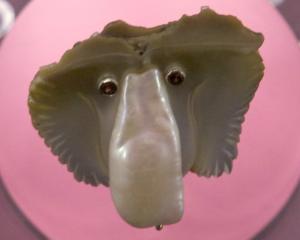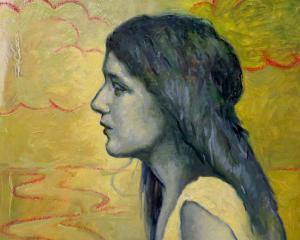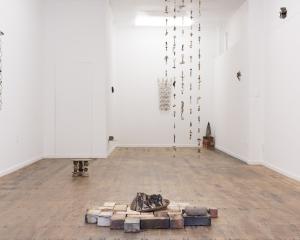Michael Harrison's gentle, luminous paintings glow with the mysteries of a personal symbolic dreamscape, yet within the warmth of his simple, effective designs there is a subtle, wistful melancholia.
Harrison's exhibition strips back his images to a series of soft enigmas in a translucent acrylic which appears almost like washes of watercolour. Within the delicate light and shade lie the arcane mysteries of the artist's symbology. Arcane is an appropriate word; at least one of the works is directly influenced by tarot card imagery, and several of the others carry a similar impression of weighty hidden knowledge.
The artist leaves the works' explanations unstated, and seems to delight in viewers' interpretations. Cats are a recurring motif, as are distant flying birds and seemingly prelapsarian human nudes. It is tempting to read the creatures as archetypes of human nature and, by analogy, as a reading of humankind's own ecological invasion biology of a pristine environment.
At first glance, one could be mistaken for seeing the paintings as too simplistic, yet the reduction of the images to bare tableaux has lent them a Zen-like charm. The balance between individual features, and between areas filled and left vacant, has given the pieces both depth and tranquillity.
One of the prints in Ben Reid's Artist's Room exhibition is entitled The Unsettling of Campbell Island, a title which could effectively be used to encompass the whole exhibition.
Reid's fine intaglio and relief prints are inspired by the artist's trip to the subantarctic island chain in 2011. Here, he was fascinated as much by the history of these settled, unsettled and resettled specks of rock as by their natural scenery. The islands were occupied first by sealers, then cleared of native fauna in an aborted attempt at farming before being returned to a new ''natural'' state by the Department of Conservation.
The drypoint and woodblock works take a view of this history that is dispassionate yet poignant and also touched with wry humour. The native birds and introduced livestock are presented against mock Victorian wallpaper, much of it decorated with motifs of introduced pests such as rats. The intention seems to be to say that each human intervention is no better nor worse than the last, and that all are destined only to temporarily detour nature from her chosen course.
The works are strong, elegant, and impressive, and show the printmaker's skills at his medium as well as his eye for both drawing from nature and graphic design.
Marion Wassenaar has recently been presenting twin exhibitions as part of her master of fine arts course. The second of these is still on display at the Gasworks Museum's fitting shop on Sunday afternoons.
The exhibition is strictly site-specific, inspired by Dunedin's industrial history and by the dwindling numbers of industrial workers in the city. The gasworks is the perfect place to explore this, with its grand machinery and overwhelming sense of loss for the gritty labour of the past.
Wassenaar's work uses processes analogous to those used by the gasworks. Rather than burning coal to produce gas and coke, the artist has started by burning paper in sealed containers to produce a brittle charcoal residue. This she has presented both in its pure form, as carbonised paper, and pulped with clay to create glossy grey-black sculptures.
The sculptures are poignant reminders of workers past: a mixed-media piece using old lockers and a haphazard array of clay boots lead to a sculpture of the blackened worker himself. The paper/charcoal works include the burnt relic of a book on the history of the industry, which sits alongside a chapbook with text from the book and prints by Wassenaar. These remind us in words and pictures of what has changed and what has remained from our industrial past.











![Rozana Lee, "Drawn to see(a)" [Installation view]. Photo: Beth Garey](https://www.odt.co.nz/sites/default/files/styles/odt_landscape_small_related_stories/public/story/2024/10/blue_oyster_r_lee.jpg?itok=IGhlKMSl)
